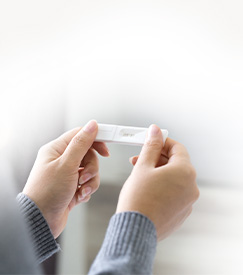Congratulations! You’ve chosen to adopt. But can you choose the child you adopt? The answer is — it depends.
Some prospective adoptive parents may incorrectly assume the adoption process is quick, they can pick the child to adopt, or that the process ends when they bring the child home.
But did you know the birth mother chooses which family adopts her child?
At Angel Adoption, we use a unique birth mother selection process and adoption matching system to pair children with prospective families.
When you choose to adopt an infant, you have input, and there are choices you can make to ensure a successful adoption. From creating a compelling profile to understanding the impact of selecting preferences, here’s what you need to know about choosing your adopted child.
Fact 1 – Birth Mothers Lead the Selection Process
As more is learned about adoption and adoptees, the adoption process has evolved, leading to a more ethical and transparent process. This is the part of the “Can you choose the child you adopt” that accounts for the birth mother’s choices.
Traditional vs. Modern Adoption Matching
Historically, a social worker or adoption agency matched a child with an adoptive family often in a “closed” adoption — meaning adoptive parents and children had limited, if any, information about the birth parents.
Modern adoption matching gives both parties more autonomy. It allows birth parents a choice in who their baby will live with and how much contact they’ll have after the adoption.
Modern matching often involves open or semi-open adoptions and more transparency. According to the National Council for Adoption, open adoptions have many benefits — from strengthening the adoptee’s sense of identity and attachment to adoptive parents to decreasing their sense of abandonment.
Keeping Birth Mothers in Charge
Angel Adoption has a birth mother selection process that allows the birth mother to set her preferences for the adoptive family and review matching families. She can “heart” profiles, add them to her Favorite Families list, and get a notification with the complete profiles. If an expectant mother chooses you, an adoption coordinator will reach out to establish communication.
At any point in the process, you or the birth mother have a right to decline the adoption.
Fact 2 – Your Profile Matters More Than Ever
How you present yourself and your family in your profile will get you closer to choosing the child you adopt. Robust family profiles are a critical part of Angel Adoption’s process.
Several factors that positively impact how the birth mother views your family’s profile, including:
Necessities of a Strong Profile
Your profile should include photos of your family or even a profile video — videos are the fastest way to build an emotional connection. Profiles are around 1,500 words and should introduce your family, lifestyle, interests, and thoughts about parenting and adoption. Remember to update your profile regularly.
Elements to Help Your Profile Stand Out
Be authentic. Remember who you’re writing this adoptive parent profile for: the birth mother. Consider what she wants to know about you. Why should she choose you to raise her baby?
Be supportive and reassuring. Avoid making any judgments or assumptions about the expectant mother and her situation.
Want to stand out? Include your opinions about ethical adoption. Discuss the importance of a transparent process, your agreement to meet all legal adoption requirements, and your consideration of the birth mother’s and baby’s well-being.
Fact 3 – The Matching Timeline Varies
Does creating a shining profile mean you can choose the child you adopt and find a match immediately? Your profile is only one part of the adoption matching system. The next part of the “Can you choose the child you adopt” answer accounts for how long your waiting preferences might be.
What Factors Affect Wait Times?
A stellar profile increases your chances of matching with a birth mother; she could reach out tomorrow or months from now. Your openness to different types of adoption, along with race, age, and gender preferences, could expedite your wait time.
Location can determine wait times, too. If you adopt the child from a state different from where you currently reside, you’ll need to complete the Interstate Compact on the Placement of Children (ICPC) process, which could take up to 14 days.
How Long Does it Take to Adopt a Child with Angel Adoption?
The average wait time at Angel Adoption is 6 to 24 months. Whether you want to adopt an infant, siblings, or multiples may affect the timeline.
Statistics show over two-thirds of children in foster care have a sibling in the system and one in every 250 pregnancies results in twins. Keeping siblings together has many positive outcomes, and birth mothers may want their children adopted together.
While wait times vary, Angel Adoption has numerous success stories of adoptive families. Of the families who adopted with an agency, 93% said they would “definitely adopt again.”
Fact 4 – Legal Requirements Shape Choices
Before considering if you can choose the child you adopt, make sure you meet all legal requirements.
Meeting Adoption Eligibility Requirements
States have different eligibility guidelines. For example, in Colorado, Texas, Oklahoma, and Delaware, adoptive parents must be at least 21. To adopt in Georgia and Idaho, state laws stipulate you must be at least 25 years old.
Angel Adoption’s requirements include a minimum age of 25. Although there isn’t an overage limit, there are ethical considerations older parents should ask themselves before becoming guardians. Our higher age limit helps birth mothers feel confident that emotionally and financially mature individuals will be caring for their infants.
There are no marriage requirements at Angel Adoption. We support single-parent adoptions, LGBTQ+ adoptions, and adoptions from any race, religion, and background.
All families are screened by a licensed social worker, have FBI background checks and completed fingerprints, and are found to be emotionally, physically, and financially ready to provide a home for a child.
Considering Interstate Adoption Limitations
The ICPC regulates the movement of children across state lines. While it prioritizes a child’s welfare, it also means gaining approval from both your state and the baby’s state.
Over 15 states require the adoptive parents to be residents before they adopt a child within that state, causing delays to adoptions from 60 days to a year. Your location could greatly impact the birth mother’s (and your) decision on where to adopt.
Navigating Special Needs Adoption
When considering “Can you choose the child you adopt,” adoptive parents should consider if their home is ready to welcome children of all abilities, including those with special needs.
Before deciding to adopt a child with special needs, learn what services children with disabilities require. Parents who want to adopt a child with special needs may need special training, a more thorough home study, and medical certifications.
Adopting a child with special needs has many rewards, and parents may have unique financial assistance available to them.
Gaining Home Study Approval
In the United States, you’ll need an adoption home study approval. This includes training, interviews, a home visit, medical and income statements, and background checks. During the home visit, the social worker will look for living space requirements like smoke detectors, a safe water supply, and more.
The home study results will determine how many children you are approved to adopt, what age those children can be, and whether you are approved for special needs adoption. This part of the “Can you choose the child you adopt” is answered by what licensed experts believe would be the best fit for your future family.
Fact 5 – Understanding Your Medical Choice Rights
Adoption agencies are responsible for providing medical records to the prospective parents. Understanding any known medical conditions, substance use, special needs, and the birth family’s health history helps adoptive parents and their doctors better care for the child.
During the adoption process, you can request what medical information you’d like to receive from the birth mother, if she feels comfortable sharing it. Additionally, many states require that a child receives a physical before an adoption can be finalized, which can help give the adoptive family more information.
Angel Adoption passes no judgment on prospective adoptive parents for their medical preferences. From caring for a child who has special needs to working with a birth mother who wants a closed adoption and, therefore, a child with a potentially unknown medical history, choose what’s best for you.
But remember, preferences create limitations in the matching system, along with increased wait times. If you’re still asking if you can choose the child you adopt, specifying these preferences may filter a selection closer to your choice.
Fact 6 – Race, Gender, and Age Preferences
Can you choose the child you adopt when it comes to demographic points? Well, you can specify gender, age, race, and sibling preferences, but it may mean longer wait times.
According to domestic adoption statistics, girls are marginally preferred and adopted at 51%. International adoptions are predominantly Asian (59%), but the majority are white (56%) domestically. If you want a shorter wait time, keep your preferences open.
About 40% of adopted children are of a different race than their parents. Displaying cultural competency can expand your matches. If the birth mother sees an adoptive family willing to understand her or her baby’s race, culture, and language, she may be more inclined to choose them.
Sensitivities around belief systems, political opinions, and socioeconomic status are also important. The understanding adoptive parents show at this time helps birth parents know the accepting nature of their child’s future home.
Fact 7 – Your Right To Choose ‘Yes’ or ‘No’
You can’t choose the child you adopt, but you can choose when to say “yes” or “no” to a child you’ve been paired with.
When to Say No
With the adoption process sometimes taking years to complete, saying “no” only to start the process over again can feel devastating. But if you aren’t prepared to care for that specific child — whatever the reason — you have the right to say no.
Adoption disruption (when an adoption is terminated before it is legally finalized) occurs for many reasons, one of which is when you, the prospective adoptive parent, decline the adoption.
Consult your adoption agency about how to respectfully decline your adoption. They may wish to do it on your behalf or might recommend you do so with their guidance.
Then, after declining a match, talk to your agency to reaffirm your commitment to the adoption process. Continue to engage with your adoption agency, attend support groups if you feel inclined, and keep your information up to date. Ongoing involvement keeps you informed and prepared for future matches.
While there is no penalty for declining, the process can be heartbreaking for both parties. It can also be costly. Adoption disruption insurance can financially protect families.
Adoption disruption is not a failure. Deciding to say “no” may hurt now, but adoption dissolution (the termination of an adoption after it is legally finalized and the adoptee enters foster care) will be more painful.
When to Say Yes
It’s important to note that while you have the right to say “no,” there’s no way of knowing when an expectant mother will choose you again. Every opportunity is a gift and a potential to say “yes.”
If you’ve been honest with yourself and articulated your accurate preferences on your profile, you’ll find matches that align with your specifications, and you’ll be more apt to choose “yes!”
In Closing: Can You Choose the Child You Adopt?
You know the answer to “Can you choose the child you adopt” by now: Technically, no. The adoption process is a sensitive, two-way street.
But… If you respect the birth mother selection process, maintain your profile, understand how your preferences impact the timeline, meet the legal requirements, learn as much as possible about adopting a child, and are honest with yourself about whether or not this baby is a good fit for your family, you will undoubtedly choose “yes!” to a child you want to adopt.
Now that you have a better understanding of choosing your adopted child, contact Angel Adoption to apply for adoption.







